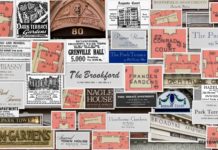“For half a century or more Mr. John F. Seaman and his wife, Ann D., were well known persons of wealth and social standing. They occupied a city house in the winter and a conspicuous and well-known marble mansion at Kingsbridge in the summer. They never had any children, and as both husband and wife were rich in their individual rights they were naturally regarded with considerable solicitude in their later years by their heirs at law and collateral relatives.” New York Herald, July 10, 1890.

“She’d been a stunning beauty in her youth.”
So they said.
“Ann and John were the plainest folks you’d meet on a day’s walk,” commented one neighbor.
But their estate, now the site of a housing cooperative called Park Terrace Gardens, was anything but plain.
If bits of Oz, Narnia and Disneyland were drizzled onto a hilltop overlooking the Harlem and Hudson Rivers where the island of Manhattan nearly kisses the continent the resulting creation might have resembled the Drake-Seaman estate.
Serene and unspoiled farmland surrounded the palace in the valley below. Downtown was but a dream.
The Seaman’s sprawling grounds, gleaming statuary and castle-like marble house at the apex of the hill led John Seaman to name his property “Mount Olympus on the Hudson.”

Neighbors had another title—they called the hilltop manor “Seaman’s Folly“— a rebuke aimed at the couple’s ostentatious display of wealth.

Ann Drake Seaman was an wildly wealthy woman with an enthralling family history—a real life descendent of swashbuckling explorer Sir Francis Drake—but like the neighbor said, terribly plain.
Periodically she’d go to town to buy shoes; which proved an awful ordeal for the shopkeeper. After spending hours trying on footwear Mrs. Seaman would place a large order only to cancel the purchase just as storeowner finished loading the goods into her waiting coach. “Terrible quality,” she would mutter.
Her temperament a spirited mix of mean and playful.
This wicked behavior kept many away from the mansion, which wasn’t a bother for the reclusive Ann who reserved all affection for her beloved Johnnie and an ever-growing retinue of poodles.
“Mrs. Seaman was always very fond of dogs,” remarked one journalist. “Whenever one of them died she would have a handsome monument erected in its memory. She also had strong sentiments regarding her own burial. ‘I want my coffin placed in the vault beside my husband’s,’ she would say. ‘Then drop the key inside and leave us for the judgment day.’” (New York Herald, August 23, 1891)
Another reporter, describing Ann’s pet cemetery, wrote, “The gravestones, white and gilded, shine with a peculiar beauty through the foliage.” (New York Herald, August 29, 1869)
Ann’s need to memorialize her beloved poodles was boundless.
“Over the entrance to the Seaman estate is a high marble archway,” wrote the New York Herald, “erected to the memory of a dog.” (New York Herald, October 9, 1904)

The arch, which miraculously survives today on a now bustling Broadway, was wide enough to clear a team of horses before the coachman began his ascent of Mount Olympus.
Ann Drake Seaman and John Ferris Seaman had been puttering about their Garden of Eden since around 1850. One news report states that her father, Thomas Drake, who died in 1800 when Ann was two years old, had willed the property to Ann. (New York Herald, February 21, 1900)
The arch was completed around 1870 at a cost of $30,000.
Ann and John both descended from lineages that span many chapters of American history.

John’s father, Valentine Seaman, was a visionary man of medicine who both introduced a small pox vaccine to a fledgling United States and created the nation’s first school of nursing.

In addition to descending from Sir Francis Drake on her father’s side, a fact of which she was quite proud, Ann’s maternal relatives had achieved fabulous fame and prosperity. Her mother was Susan Morgan, whose family launched a financial and banking dynasty.
Throughout their marriage Ann insisted on keeping the couple’s finances separate.
John had inherited, then lost, a sizable fortune, but Ann’s bank accounts and downtown real estate holdings would have been considered generational wealth had the couple produced any children, which they did not.
Ann and Johnnie had married inside Trinity Church in 1837.

The 1860 Federal Census shows John and Ann sharing the marble castle with four servants, Mary J. Vanderzee, age 11 (black), Jane Egberts, age 30 (black) Caroline Kelly, 19 (Irish) and James Steward 26, (black).
Nearby neighbors included William Bradley Isham, John Cumming, Isaac Dyckman, Jacob Post and sea captain William Flitner.
End of the Dream
In the spring of 1872 tragedy visited Mount Olympus. John Seaman and his brother, Thomas, drowned together in a terrible accident.
Ann never recovered from Johnnie’s death. Her eccentric behavior became increasingly acute.
Then, like a whisp of smoke, she seemed to disappear completely.
A one-sentence notice in the New York Evening Post recorded her death on March 4, 1878. The cause was not noted. A later account stated she died within two weeks of catching a cold. (New York Herald, July 19, 1890)
But the newspapers weren’t finished with the Widow Seaman. Intimate moments of this intensely private woman’s life soon played out like a soap opera as countless kinfolk battled for Ann Drake-Seaman’s millions. The combined estate was said to be worth as much as five million dollars.
The Trouble with Larry
In her final years Ann Drake Seaman invited a distant relative, Lawrence Drake, to share her home on Mount Olympus.
Visitors described Larry Drake’s surreal new realm.

“The parlors are capacious, with ceilings sixteen feet high, and would do for the throne rooms of a small empire or the east room of a presidential mansion. Venetian mirrors reflect distances and apparently double the size.” (New York Herald, August 29, 1869)
Shocked guests bore witness to a bizarre dynamic that had taken hold in John Seaman’s absence.
“He was king,” wrote one newspaper of Lawrence Drake. “His will was law and the old lady obeyed it.”

“The marble palace was a prison,” the account continued, “rather an asylum for the insane. In the course of time, it is alleged, she began to harbor the delusion that Lawrence Drake owned the marble prison and that it was through his goodness of heart that she was permitted to live there. She spent hours dusting imaginary dust off the furniture. Then she would toss gold pieces into the air and leave them on the carpets. When callers came she would introduce them to the coins as if they were human beings.” (New York Herald, August 21, 1891)
Persons unfamiliar to friends and neighbors were crashed out in every available room. Some would later demand a share of the estate. It was a weird scene.
Larry Drake strode though the home’s gilded corridors liked he owned the place.
Perhaps in his mind he already did.
The Second Will
During this period Ann Drake Seaman allegedly drew up a new will.
While she had previously planned to donate the bulk of her estate to charity, Larry would now receive nearly everything.
“In this document,” reported the Herald, “she gave Lawrence Drake, a second cousin, and his family the bulk of her property. The will also includes a few more relatives, to whom she made moderate bequests, and the charities were left out in the cold.” (New York Herald, July 10, 1890)

145 so-called relatives contested the will. Many hadn’t seen Ann in years.
Some called the document an outright forgery. Others questioned Larry’s influence over the mentally infirm and aged millionaire. Lawrence Drake’s legitimacy as a true relative was also contested.
“Lawrence Drake claims to have been the second cousin of Mrs. Seaman,” one witness told the court. “Why his grandfather’s mother was only a half great-grandaunt to him.” (New York Herald, August 21, 1891)
Media Coverage
Newspapers breathlessly relayed the latest salacious details from the courtroom.

“Numerous eccentricities, as well as feebleness of body and mind and failure of memory are attributed to Mrs. Seaman by the contestants of her will, as disqualifying her from making a lawful disposition of her property,” wrote one journalist. (New York Herald, July 10, 1890)
Perhaps she had lost her mind after the death of her husband?
Details emerged that Ann nearly drowned in the Harlem River not long after her husband’s death under similar circumstances.
In February of 1873 she fell from the gangplank of the Tiger Lily, a paddle steamboat that plied the waters between her home on Spuyten Duyvil Creek and the High Bridge to the south.
“She smilingly said when brought ashore,” reported the press, ‘Why, I could have sailed around for years without any harm.’ She consented after a time to reward the sailor who had rescued her, and give him twenty-five cents. Subsequently she was persuaded to give him $5.” (New York Herald, August 23, 1891)
But was Ann Drake Seaman the “imbecile” her relatives portrayed in the courtroom?
Some felt she was simply an eccentric.
“There were times when she would startle those about her by her unexpected bursts of shrewdness. ‘Yes, I know Lawrence Drake gives me fine presents,’ she once said, ‘but he buys them with my own money.’” (New York Herald, August 23, 1891)
In November of 1890 the case took a sinister turn when a lawyer named Townsend was pushed off the high cliffs of the Palisades nearly opposite the marble mansion. The plaintiff’s attorney claimed to have discovered important evidence before he was silenced. Another litigator, George Wilson, received an anonymous post card not long after that read, “Take care you don’t follow Townsend.” Wilson told reporters that he was not afraid as the case rolled on. (Omaha Daily Bee, 1891)
Conclusion
In the end Lawrence Drake won the battle over the Seaman-Drake estate. A judge dismissed the lawsuit and admitted the will to probate in 1893, though the complainants continued to argue over the division “as though no will had been made.” (The World, February 21, 1900)
Drake sold the property to Thomas Dwyer in 1906. Dwyer resided on the estate, using the arch as an office for his architectural firm, through the 1930’s.

In 1938 Dwyer sold the Seaman Mansion to real estate developers who, without ceremony, demolished the former “Mount Olympus” to make room for a four hundred unit housing complex called Park Terrace Gardens.

Today the only visible traces of this once magnificent estate are Seaman Avenue and Ann’s crumbling marble arch—her monument to a dog.
Ann and Johnnie are buried in St. Paul’s Cemetery in Mount Vernon, New York where together they await judgment day.









What a story thanks Cole. It would have been nice if the Wall could have gotten some respect as a part of history. Instead it is stuck behind store,garages et.. So much of Inwood’s history was just ignored in order to make money building apt houses.
Fabulous story-telling, Cole!
And I thank God that those apartments were built. If not, so many of us would not have had the opportunity to grow up in such a great neighborhood.